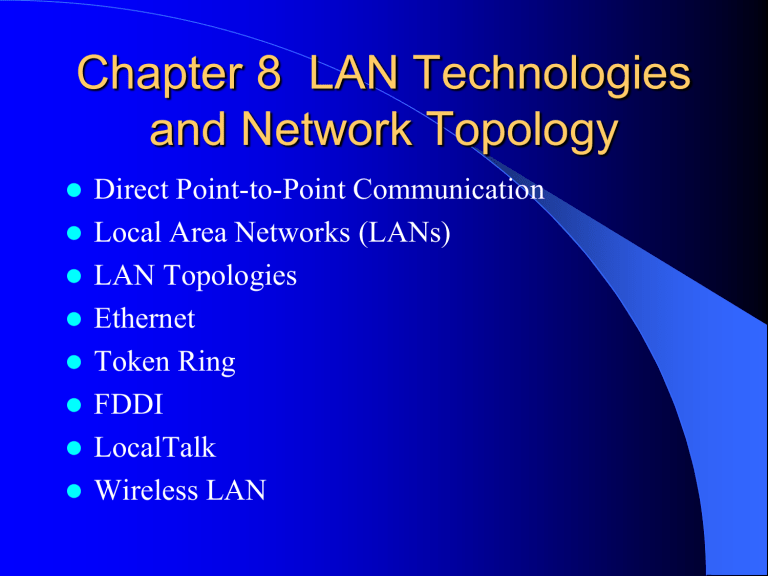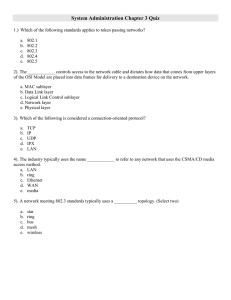
Chapter 8 LAN Technologies and Network Topology Direct Point-to-Point Communication Local Area Networks (LANs) LAN Topologies Ethernet Token Ring FDDI LocalTalk Wireless LAN Direct Point-to-Point Communication used in early computer communications systems Advantages - Each point-to-point connection can use different network hardware, frame format, and bandwidth (fig 8.1) - Each point-to-point connection has exclusive access - Easy to enforce security and privacy Disadvantages - fully meshed network becomes exponentially expensive as number of nodes increases (fig 8.2) - number of direct connections required = (N2 - N) / 2 Local Area Networks (LANs) based on sharing the same communications medium. emerged in 1980’s in local communications as alternative to expensive, dedicated point-to-point connections shared networks confined to local communication because – – – more time would be spent coordinating the of sharing of network and less time spent actually transmitting data if two nodes are separated farther apart Cost of providing high bandwidth is more expensive over long distance than over short distance Locality of reference: computers usually communicate to another nearby computer. LAN Topologies Star network – all computers attached to a central point such as a hub (fig 8.3) – Fault tolerant advantage Ring network – computers are logically arranged in circular loop (fig 8.4) – Physical orientation may be different ( offices on various floors using token ring). – One bad cable may disable the entire ring. – Token ring may be logical ring but physical star. Bus network – usually consist of a single shared long cable to which computers attach (fig 8.5) – One bad cable may cripple the entire bus. – Ethernet network can be logical bus but physical star. Ethernet Network Manchester Encoding (fig 8.6) Originally a bus network (ANIM06_1.MOV) in which multiple computers share a single transmission medium. While one computer transmits a frame, all other computers must wait (fig 8.7) Uses CSMA (carrier sense multiple access with collision detect) (ANIM06_2.MOV) Uses binary exponential backup in recovering from collision. Delay time is doubled after each successive collision. Wireless LAN Uses antennas to broadcast RF signals through air Carrier Sense Multiple Access with Collision Avoidance CSMA/CA (fig 8.8) IEEE 802.11b – – – – Up to 11 Mbps frequency hopping spread spectrum (FHSP) direct sequence spread spectrum (DSSS) radio frequencies in range of 2.4 GHz - 2.483 GHz IEEE 802.11a – Up to 50 Mbps – radio frequencies in range of 5 GHz LocalTalk Network bus network designed by Apple. Uses modified CSMA/CA (a short message is sent to reserve the medium before transmitting a large message) Limited to 230 kbps Easy to install: daisy-chain computers (fig 10.9) Token Ring Network token passing ring network (fig 8.9) IBM’s token ring operate at 16Mbps token is a special bit pattern or message different from normal data frames (bit stuffing of data may be used) only one token circulates the ring at any time. To send data, computer waits for token to arrive, transmit one frame, and then pass token to next node (ANIM06_3.MOV) guarantees fair access because nodes take turns. FDDI Network Fiber Distributed Data Interconnect (FDDI) token ring technology operating at 100 Mbps using fiber. Uses counter rotating ring for fault tolerance (fig 8.10) Self healing – Ring is still up if there is one break in the ring




